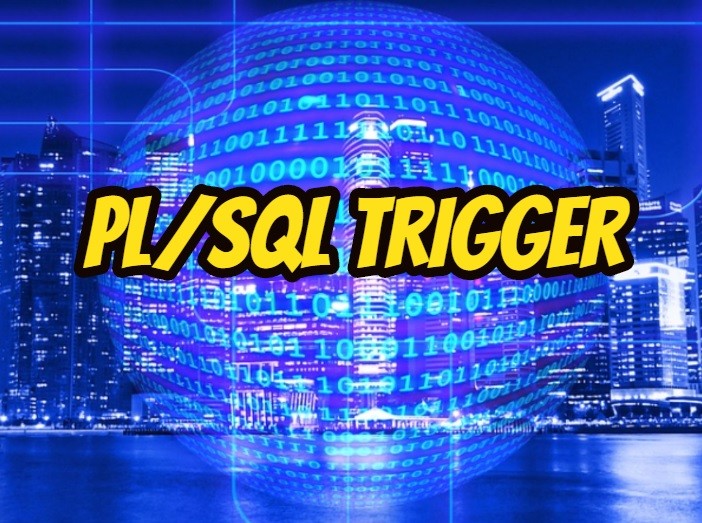This article contains information about Oracle PL/SQL Trigger, Types such as DML,DDL and Datase Triggers and examples.
What is Trigger in Oracle PL/SQL?
The structure used to run a specific command after or before various operations on the database is called a trigger.
Triggers have the same structure as the procedures in PL / SQL.
The most important feature that distinguishes the triggers from the procedures is that the triggers run automatically after an event.
For example after or before an insert. The keywords to be used when creating a trigger are as follows.
|
1 2 3 4 5 6 7 8 9 10 11 12 13 14 15 16 |
CREATE [OR REPLACE ] TRIGGER My_Trigger_Name {BEFORE | AFTER | INSTEAD OF } {INSERT [OR] | UPDATE [OR] | DELETE} [OF My_Column_Name] ON My_Table_Name -- When you specify Referencing, then you can use this keyword in triggered sql statement. For Example->MyOld.DeletedRowId [REFERENCING OLD AS MyOld NEW AS MyNew] [FOR EACH ROW] WHEN (My_Condition) DECLARE -- definitions BEGIN -- commands EXCEPTION -- exception handling END; |
Trigger Types in Oracle PL/SQL
Triggers are operated in the following cases.
DML Triggers– INSERT, UPDATE, DELETE
DDL Triggers– CREATE, ALTER, DROP
Database Triggers – SERVERERROR, LOGON, LOGOFF, STARTUP ve SHUTDOWN
DML Triggers in Oracle PL/SQL
It is often used to record transactions in DML operations.
Before Insert Trigger in Oracle PL/SQL
In the example below, it will print “New Product inserted.” on the screen before the record is inserterd to the Products table. Because this is before insert trigger.
If we use AFTER instead of BEFORE as a keyword, then it will print “New Product inserted.” on the screen after the record is inserterd to the Products table.
|
1 2 3 4 5 |
CREATE OR REPLACE trigger TRIGGER_NEW_PRODUCT BEFORE INSERT ON PRODUCTS BEGIN DBMS_OUTPUT.put_line('New Product inserted.'); END; |
Also there are triggers like BEFORE INSERT TRIGGER as below.
- Before Delete Trigger
- Before Update Trigger
- After Insert Trigger
- After Delete Trigger
- After Update Trigger
The transaction can be recorded by adding a record to another table within the BEGIN and END block.
|
1 2 3 4 5 |
CREATE OR REPLACE trigger TRIGGER_NEW_PRODUCT BEFORE INSERT ON Products BEGIN INSERT INTO INTO Log(table_name, log, user, date) VALUES('Products', 'Insert', USER, SYSDATE); END; |
It will be sufficient to add a record to the Products table to run the trigger.
Disable Trigger in Oracle PL/SQL
The ALTER and DISABLE keywords are used to disable the trigger.
|
1 |
ALTER TRIGGER trigger_name DISABLE; |
Enable Trigger in Oracle PL/SQL
The ALTER and ENABLE keywords are used to enable the trigger.
|
1 |
ALTER TRIGGER trigger_name ENABLE; |
List Triggers in Oracle PL/SQL
SYS.user_triggers table can be used to get information about triggers.
|
1 |
SELECT trigger_name, status FROM SYS.user_triggers; |
Drop Trigger in Oracle PL/SQL
The DROP keyword is used to delete the trigger.
|
1 |
DROP TRIGGER trigger_name; |
Enable ALL Triggers on Table Oracle PL/SQL
|
1 |
ALTER TABLE table_name ENABLE ALL TRIGGERS; |
Disable ALL Triggers in Table Oracle PL/SQL
|
1 |
ALTER TABLE table_name DISABLE ALL TRIGGERS; |
Note: Using too many triggers can cause a bottleneck on the database server.
You can find more detailed information about below topics in the below link.
You will find below topics in this article.
- What is PL/SQL
- Oracle PL/SQL Data Types and Variables and Literals
- Oracle PL/SQL Operators
- Oracle PL/SQL Conditional Statements
- Oracle PL/SQL Loops
- Oracle PL/SQL Procedures and Procedure Parameters
- Oracle PL/SQL Functions
- Oracle PL/SQL Cursor
- Oracle PL/SQL Records
- Oracle PL/SQL Exception
- Oracle PL/SQL Trigger
- Oracle PL/SQL Packages
- Oracle PL/SQL Collections
You can find more information about triggers at docs.oracle.com
